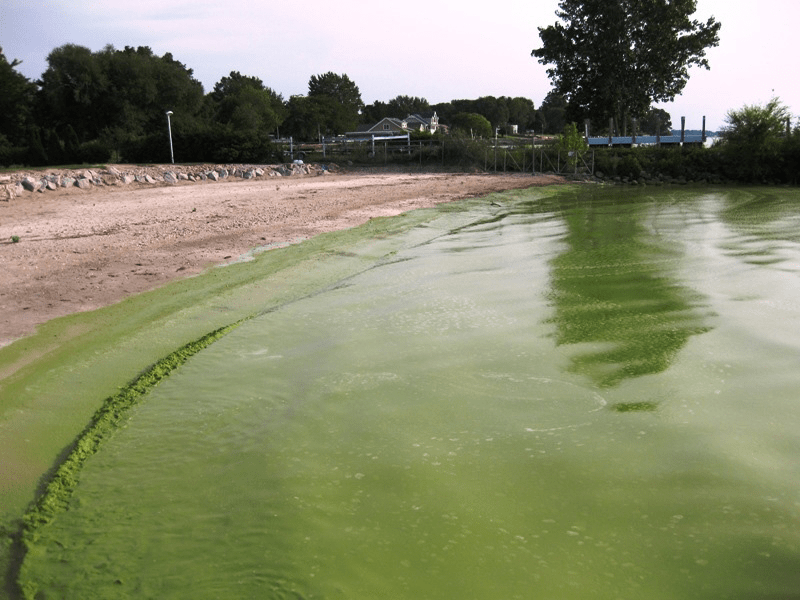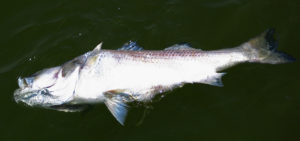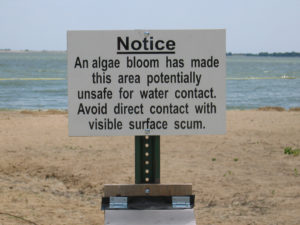We have much more to do and your continued support is needed now more than ever.
Harmful Algae Outbreaks may cancel Summer Swimming Plans

For many people, summer means soaking up the sun and cooling off with a nice swim. But harmful algae in our waterways may put a damper on summer plans. While some green algae is made up of harmless, free-floating plants called phytoplankton, another type of blue-green algae is made up of toxic cyanobacteria. This dangerous algae forces many beaches to close each year.
How does these toxic algae outbreaks happen?
Algae blooms are natural, but human activity is putting them on steroids, creating huge, toxic outbreaks. Nitrogen and phosphorus runoff from fertilizers and nearby agriculture can flow into lakes and streams and pollute the waterways by making the levels of nutrients in the water too high, fueling unnaturally large blooms. Climate-disrupting carbon pollution also worsens summer algae problems by giving algae the warmer water temperatures it likes.
What’s so dangerous about it?
When the toxic blue-green algae blooms in a waterway, it will force beaches and lakes to close. This happens every year and makes swimming off limits because of the toxic threat the cyanobacteria poses to people, fish, and other aquatic life. When people, fish, and wildlife are exposed to high levels of this toxic algae, the toxins can be taken up by the liver — affecting liver functions and potentially causing liver damage. Wildlife can be affected both by direct exposure to the toxic algae as well as by eating food that contains the algae toxins.

Unfortunately, the toxic algae can also affect birds and pets. Field studies have shown that songbirds, gulls, and even hawks have died from overexposure to the deadly toxins. In the Chesapeake Bay region, scientists have even found Great Blue Herons that have killed by the toxic algae. Pets can also be affected by the algae, so if algae blooms are reported in your area, keep your pets away from the affected waterways. The Environmental Protection Agency (EPA) recommends that you stay away from any green, scummy water or any waterways that have an unpleasant smell, just to keep yourself and your pets safe.
When and where do these algae blooms occur?

Toxic algae blooms can occur anywhere there are the warm, calm, nutrient-rich waters for them to grow, but reports are most common from May to September throughout the country. The National Oceanic and Atmospheric Administration (NOAA) has an online forecasting tool for HABs that you can check out to see if any blooms have been reported in your state. NOAA also has a volunteer network to report blooms called the Phytoplankton Monitoring Network that you can use to check reports and report any potentially harmful blooms that you find in your area.
How can we prevent algae blooms in the future?
As climate change makes the summers more intense, the amount of algae in lakes, rivers, and streams will only continue to increase. So the more we can embrace solutions to climate change more broadly, the more we can help prevent future harmful algal blooms.
- At home, you can help prevent nutrients from entering waterways in a few different ways. When buying detergents and cleaning products, look for ones that say “phosphate-free.” Make sure to use the correct load size, only use as much detergent as you need, and only run the washer when you have a full load of clothes. When washing your car, take it to a commercial car wash in order to dispose of wastewater properly. If you are going to wash your car at home, make sure to properly dispose of wastewater and use “phosphate-free” soaps to clean your car.
- When walking your dog, always pick up after them to avoid runoff into waterways. You can also prevent pet waste from entering waterways by walking them in parks, grassy areas, and open lots instead of walking them along streams or near ponds. This will greatly decrease the amount of waste that enters the water supply. You can find more information about what you can do at home on the EPA’s website.
- Get the word out in your community so more people are aware of how their personal choices can contribute to harmful algal blooms and climate change. National Wildlife Federation has great programs that you can join to certify your home, school, or workplace as a Certified Wildlife Habitat. It’s easy and fun and a great way to make your community more sustainable while inviting more wildlife to visit your home or work. Schools can join NWF’s Schoolyard Habitats and Eco-Schools USA programs as a way to join over 5000 schools that use wildlife habitats at their school as outdoor classrooms and as a way to teach the next generation of kids the importance of conservation.
If we all spread the word and do our part to decrease the conditions that lead to harmful algal blooms, we can make sure that nothing will interrupt our summer fun!





















